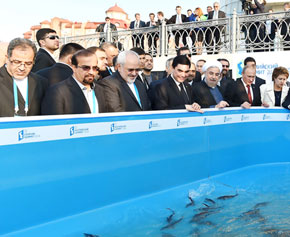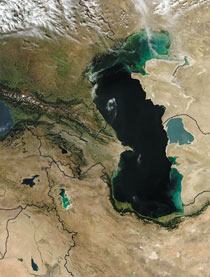The presidents of the five countries that surround the Caspian Sea gathered in the Russian port city of Astrakhan on 29 September 2014 for the Fourth Caspian Summit. President Vladimir Putin of Russia, the host, gave an upbeat assessment of the summit outcome, portraying it as a “breakthrough”, a sentiment that was echoed by President Nursultan Nazarbayev of Kazakhstan.
Similarly, President Ilham Aliyev of Azerbaijan, and Iranian President Hassan Rouhani underlined the “common political will” of the littoral states to reach a consensus to resolve the fundamental issues pertaining to the Caspian Sea.
At the summit, the presidents signed three agreements: on hydrometeorology co-operation in the Caspian Sea, on co-operation on disaster warning and relief in the Caspian Sea and on preservation and rational use of Caspian Sea marine biological resources.
But the “breakthrough” referred to by the Russian president was something more than these agreements.
Political declaration
One of the biggest achievements of the summit, Mr Putin said, was the considerable progress made in preparing the future convention on the legal status of the sea and the delimitation of its marine areas, seabed and subsoil resources and on the rules governing navigation and fishing. Accordingly, the five presidents signed a 19-point joint document that highlights the basic principles that will govern the final text of the convention.
One of the most important agreements in this document is that each country will have national sovereignty over a 15-nautical mile zone from its shoreline and will have the exclusive right to fish an additional 10 nautical miles beyond the 15-mile zone.
Though the Fourth Summit was a departure from the earlier ones and good progress was made with regard to environmental issues, fisheries, shipping and scientific research in the Caspian region, there is a long way to go before a legal regime is finalised. One of the reasons for this situation is the unilateral measures taken by Azerbaijan, Russia and Kazakhstan in dividing the northern part of the sea. The Caspian states have convened hundreds of meetings at various levels to resolve this problem in the last 18 years since the collapse of the USSR.
It is hoped that a draft convention for the legal regime of the sea will be prepared for final discussion and signing at the next summit. The date has yet to be agreed but the summit will be held in Kazakhstan. Meanwhile, the other documents that have been adopted by the Fourth Summit can hardly be implemented in the absence of a legal regime.
What’s in a name, sea or lake?
The experts who will be working on a draft resolution will face the highly challenging task of divvying up the Caspian Sea, especially the issue of determining specific methods to define the starting coastline for calculations.
From a legal point of view, the Russo-Persian Treaty of Friendship (1921) and the Treaty of Trade and Navigation (1940) between the former USSR and Iran are the sole legally valid treaties with regard to the legal regime of the Caspian Sea. Both of these treaties are still in effect, as the CIS countries undertook in 1991 to observe the international treaties of the former USSR. According to the treaties, the Caspian was exclusively a USSR-Iranian sea with the Soviets controlling the northern 80 per cent and the Iranians controlling the southern 20 per cent. With the dissolution of the USSR, the Caspian Sea and its resources became a source of tension for all five littoral states.
The underlying issue is anomalous in light of its misleading simplicity. That is, whether the Caspian is a sea or a lake, with each term representing a different regime with specific economic and strategic impacts.
There are two internationally recognised regimes that can be applied to the Caspian Sea. The first one is the UN Convention on the Law of the Sea (UNCLOS), which was approved in 1982. According to UNCLOS, access to an ocean is a major criterion in determining the status of a sea. The Caspian is connected to the Black Sea through the Volga-Don Canal and the Baltic Sea via the Volga-Baltic Canal. Therefore it could be considered a sea. Under this regime, the economic activities of each littoral state are extended up to 200 nautical miles from their coastline. However, since the Caspian is only some 234 nautical miles at its widest point, it is too small to come under UNCLOS.
The other regime is that of internal waters which are not subject to UNCLOS and from the viewpoint on international law, internal waters, including lakes, have the same legal characteristics of land boundaries and they should be determined on the basis of consensus and agreements among neighbouring states, a point that was clearly reflected in the final statement of the Second Caspian Sea Summit in Tehran in 2007.
With no collectively agreed legal document about the division of the Caspian Sea, each littoral state has argued for agreements that best suit its own critical interests. The result is a complicated regime characterised by bilateral treaties in the northern Caspian Sea and disputed boundaries in the southern Caspian Sea.
 Taking time out from the conference hall, the presidents of the Caspian coastal states watch as young sturgeon are released into the River Volga at Astrakhan
Taking time out from the conference hall, the presidents of the Caspian coastal states watch as young sturgeon are released into the River Volga at AstrakhanThe states with long coastlines favour sea status of the Caspian as it would provide them with more seabed and, as a consequence, would maximize their access to oil and gas. In contrast, the states with short coastlines prefer lake status, which means that each of the five Caspian states would get a 20 per cent share.
As a result, Russia signed a bilateral agreement with Kazakhstan in July 1998 and with Azerbaijan in January 2001. Similarly, Azerbaijan signed a bilateral agreement with Kazakhstan in November 2001. With their bilateral agreements these countries claimed nearly 71 per cent of the Caspian seabed by pooling their coastline lengths and the remaining 29 per cent of the seabed in the southern part of the Caspian Sea is left to Iran and Turkmenistan.
Because of its small coastline, if Iran agreed to bilateral agreements based on sea status, its share would be roughly 12.5 per cent of the seabed. For this reason, Iran does not recognise the northern Caspian Sea bilateral agreements. Iran believes that the Caspian Sea is a lake and therefore it should be divided into five equal sectors, i.e. 20 per cent of the seabed going to each of the Caspian States.
Azerbaijan and Turkmenistan disagree with Iran’s approach and it would suit them for the seabed to be divided primarily along the ‘median line’ or the length of their coastlines. The position of Azerbaijan is reflected in its constitution of 1995, which says that soil along with its mineral wealth, inland and territorial waters, continental shelf, flora and airspace over Azerbaijan territory are the exclusive ownership of the republic. The official position of Azerbaijan is that the seabed must be divided on the basis of the equidistance or median line principle.
Thus the division of the northern Caspian Sea has thrown up sharp differences among the littoral states, one of which is the dispute between Azerbaijan and Turkmenistan over three oilfields in the Caspian Sea, including the Kapaz-Sardar oil field.
Caspian’s exclusivity, naval arms race
Besides the legal regime, another important topic discussed during the Fourth Summit, a follow up from the previous one, was the maintenance of security in the Caspian Sea. At the Third Summit in Baku in November 2010, the leaders of the five states signed an agreement on security co-operation, which was one of the main points of the summit’s agenda.
Emphasising the inadmissibility of foreign military presence in the Caspian Sea, President Putin at the Fourth Summit said that the 19-point document signed by the five presidents sets out a fundamental principle for guaranteeing stability and security, namely, that only the Caspian littoral states have the right to have their armed forces present on the Caspian.
His Iranian counterpart, Hassan Rouhani added: Littoral states can provide stability and security in the region without the presence of extra-regional forces.
The move comes amid the increasing co-operation of some littoral states with the US and European countries on security and energy issues, growing efforts of NATO officials to improve military cooperation with Russia’s “near abroad” and naval arms proliferation in the Caspian.
Azerbaijan is a case in point. Since its independence in 1991, the country has emerged as a strategic partner of the West due to its oil and gas riches flowing westward through pipelines (Baku-Tbilisi-Ceyhan, Baku-Tbilisi-Erzurum and the planned Southern Corridor).
As noted by President Ilham Aliyev at the NATO summit in Wales, Azerbaijan is a “reliable” partner for NATO. Azerbaijan has been part of the International Security Assistance Force (ISAF) in Afghanistan since 2002 and provides logistical support for NATO operations in this country.
Kazakhstan has been trying to boost its defences on the Caspian. Kazakhstan is buying Corvettes with anti-ship missiles, building an air base in the port city of Aktau and increasing its naval manpower. Azerbaijan in turn is strengthening its radar and command and control systems and Turkmenistan is also trying to increase its naval forces in the Caspian Sea. Iran with a force of some 90 vessels is going to deploy its first destroyer into the sea and Russia, the strongest naval force in the Caspian Sea with over 150 vessels, is planning to further increase its military presence in the sea.
Definitive agreement?
In his speech at the Fourth Summit, President Putin admitted that there are outstanding issues that have to be resolved. Yet he labelled the summit a breakthrough and expects a definitive agreement on the legal regime of the Caspian Sea at the next summit in Kazakhstan. However, despite the diplomatic subtlety and the emphasis on co-operation and the need for better co-ordination and interaction shown during the Fourth Summit, the question of how to bridge the gap between the claims of the littoral states, particularly how to divide the southern Caspian Sea among Iran, Azerbaijan and Turkmenistan, remains an extremely important factor in coming up with an acceptable legal regime for the Caspian Sea.
About the author: Hossein Aryan, a former British-trained Iranian naval officer, worked as a senior correspondent for Radio Free Europe/ Radio Liberty's Iranian Service. He has previously been a monitoring journalist with the BBC and a part-time lecturer in Middle East Politics at Newcastle University.



